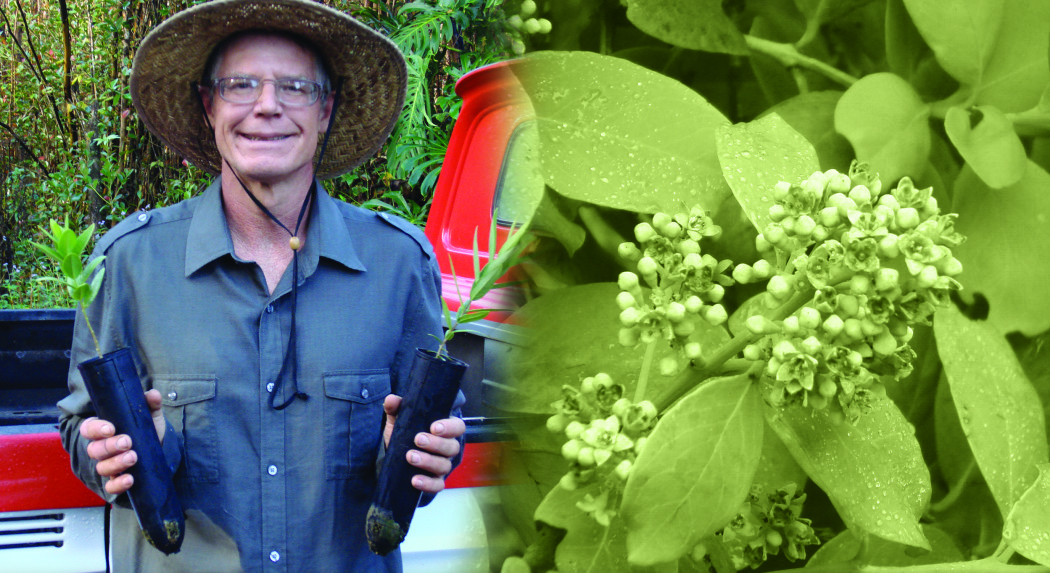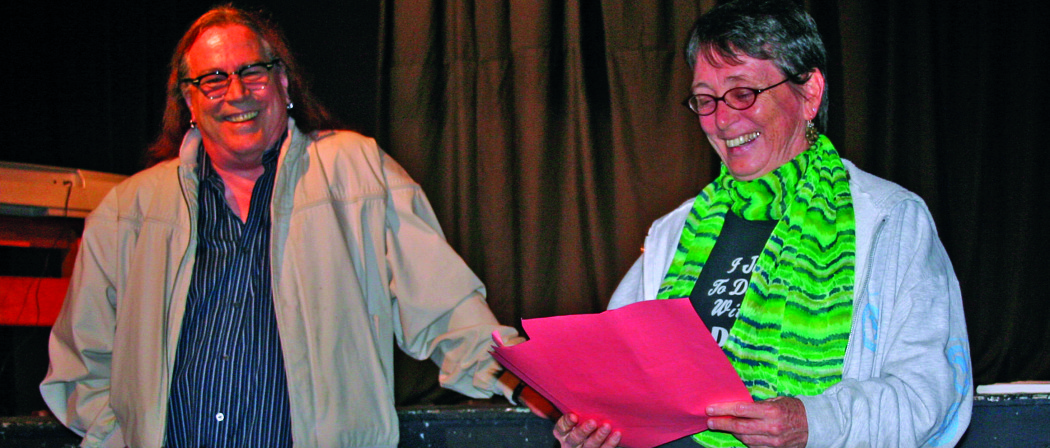
The Story of `Iliahi: Sandalwood, A Saga of Destruction and Rebirth
 By Tim Hall
By Tim Hall
When the first humans stepped from their sailing canoes onto the shores of Hawai‘i, the islands were covered with (‘iliahi)—sandalwood. They brought with them a number of alien species; almost all were brought on purpose. Others were hitchhiking, hiding in the time capsule in which they traveled such a far distance. Pigs, dogs and chickens were introduced intentionally, whereas other animals, such as rats, geckos, skinks and many other species were stowaways.
These first Hawaiians also brought their traditional ways of life and resource management. clearing the lower forest land for agriculture and diverting streams to artificially irrigate constructed pond fields (lo‘i), where they cultivated the staple of their diet, taro. They also constructed rock walls in shallow reef areas and created fish ponds. This was part of their concept of stewardship for the land – the ‘āina.
Hawaiians used sandalwood mainly for minor medicinal treatments and to scent kapa, the bark cloth used for clothing and bedding. They couldn’t comprehend foreigners’ singular obsession with the tree, a revered and precious treasure in Asia. In 1790 Captain John Kendrick made a stop at Kaua’i to replenish the ship’s wood supply. On his sail from Kaua’i he smelled the sweet aroma of Hawaiian sandalwood, and the captain’s discovery put Hawai‘i on the map as an important trading country. There was enormous demand for sandalwood in China, where the fragrant wood was used in the manufacture of incense and fine pieces of furniture. The traders received good prices for the sandalwood by trading it for silks and porcelain, which they sold in the U.S. for huge profit.
Most of the sandalwood sold in China was white and was imported from India and the East Indies. At the end of the 18th century, the supply of this wood was insufficient to feed China’s demands. As the value of sandalwood increased, the Hawaiian islands emerged as a major source of heartwood sandalwood. Hawai‘i soon became known as “Tahn Heung Sahn,” the sandalwood mountains. A traditional Asian unit of weight, a picul—defined as a shoulder-load, or the amount that a man can carry—was 133-1/2 pounds. One picul sold for $8. In the early years, American entrepreneurs dealt with the King and chiefs, and King Kamehameha eventually had an exclusive monopoly over the sandalwood trade.
He accumulated large amounts of luxury goods, often paying inflated prices. With promises of sandalwood payments, he purchased many ships. He even bought his own brig, which he named Ka‘ahumanu, and tried to enter the sandalwood trade himself. In 1817, he set sail with Captain Alexander Adams. His venture failed to make a profit (a result of brokerage fees and port charges at the Chinese port). He came to recognize the value of charging pilot and port fees, and the King quickly applied this practice at Honolulu Harbor. Every ship was now required to pay 80 Spanish dollars for anchorage at the inner harbor.
The common people were ordered by the King to go up the mountain to cut sandalwood and carry the ‘iliahi harvest to the harbor. After the bark and sapwood had been adzed off, the men would tie the heavy wood bundles on their backs and carry it down trails to areas that were dug to the same dimensions as the hulls of the cargo ships that transported the sandalwood to China. The carrying of this oil-rich wood created calluses on the shoulders of the men.
Hawaiians had a name for them, Kua-leho, or callous back.
Much of this sandalwood was stained with blood, and many Hawaiians died from the corroding effects of exhaustion, disease, malnutrition, and exposure to chilly, wet mountain winds without adequate clothing. They would cut sandalwood by day and, with the aid of sandalwood torches, at night.
All the people—chiefs and commoners—worked at cutting and carrying sandalwood. Consequently, the crops were neglected and famine fell like a dark cloud over the sandalwood mountains.
When Kamehameha realized that his kingdom was in the grip of famine, he ordered the chiefs and commoners to not devote all of their time to cutting sandalwood. He allowed them to return to their villages and placed a kapu (ban) on the cutting of small sandalwoods in an effort to conserve this resource.
In 1819, King Kamehameha died, passing the throne to his son Liholiho. The old kapu system was abolished, and he was persuaded to give the chiefs a greater share in the sandalwood trade. The 1820s were an era of active sandalwood trade. American ships were selling 1,400 tons of the wood per year to China. The King and chiefs bought ships and many expensive items on credit from the American merchants, with no regard for how much debt they owed.
By 1821, the native debt had risen to $300,000. The King and chiefs could purchase items by merely signing promissory notes. This was disastrous to the welfare of the maka’āinana and the sandalwood. Soon the easily accessible stands of sandalwood had been harvested and they had to go farther up the mountain. The new king had a short life. He died in 1824 of a contagious disease he contracted on a royal visit to London.
The kingdom was passed on to Kamehameha III along with a huge debt of $500,000 owed to the American traders. The pressure on the King was great. In December, 1826, the kingdom’s first written law, a sandalwood tax, stated that every man was required to deliver one-half picul of sandalwood to the governor of the district to which he belonged, or to pay, in lieu thereof, four Spanish dollars, on or before September 1, 1827. Every woman 13 years and older was required to weave a 12-foot by 6-foot mat, or a quantity of tapa—or kapa—cloth of equal value. Again, commoners were forced to abandon their crops, and food shortages plagued the islands. The accessible sandalwood was all gone, making it more difficult to locate trees with adequate heartwood to meet the new tax requirements.
Unjust demands caused so much hardship for the commoners that they pulled up the young sandalwood trees so that their children would not be forced to live the same life. By 1840, the Hawaiian sandalwood trade had come to a halt because of the low quality of the remaining heartwood in the islands. The Americans introduced cattle, goats and grasses into the native forest. This did not provide the ecological conditions conducive to regenerating native vegetation. For many years the trade fell dormant, and sandalwood was widely assumed to be extinct.
The earliest recorded attempt to re-grow native sandalwood was between 1851 and 1871 by Dr. William Hillebrand, an avid botanist and horticulturist, on his Honolulu homestead. His efforts to grow the tree were a total failure, and he attributed the problem to the parasitic nature of the species, indicating “all attempts to propagate them” in his garden failed.
The Territorial Division of Forestry was formed in 1903, and the first modern forest reserve system was established in the islands. The major objective was to improve watershed conditions by removing alien cattle and replanting large areas of uplands that had been cut, burned and overgrazed. The division also began the development of commercial forestry with some native plant propagation and protection. As a result, some populations of native sandalwoods made a comeback in the first three decades.
In 1930, Indian sandalwood was selling for $500 a ton in New York. Pound for pound, this wood was the most valuable in the world. The forest service had begun importation of seeds from India in 1930 and started an experimental grove in Hawai’i of more than 1,500 plants. This was finally a success; they paid attention to sandalwood’s need for a host plant, without which the seedling perished before reaching a year old. The host plant used was Acacia Koa, a very fast-growing Hawaiian hardwood. Headlines in the Honolulu Star Bulletin read “Sandalwood, Once the Gold Mine of Hawai‘i, is Coming Back.” They also tried a few native Freycinetianum sandalwoods, but they never germinated. Most all the trees died, and one that survived attained a trunk diameter of less than six inches after a quarter-century. The interest in growing sandalwood by the forest service faded fast.
In 1992, a man named Mark Hanson had a dream in which the island of Kaho’olawe was crying out to him. She told him to go to the mountain, pick the native seeds, grow the trees,and plant them with the youth of today for their tomorrow. He hiked the mountain and gathered many native seeds from sandalwood and any other native species he could find. In March of the next year, the first sandalwood sprouted in his nursery.
Two years later, 41 sandalwoods and 30 other native trees were planted on one acre of Kaonoulu ranch land. That same year, a youth group concerned with native environment, planted 50 sandalwoods and 25 mamane trees in the Kula Forest Reserve. At this time, they nicknamed Mark “The Sandalwood Man,” a modern-day Johnny Appleseed.
In 1994, Hanson started the “Hawaiian Reforestation Program” and drafted the first “Forest Recovery Act Bill.” To stop the destruction of the native forest, all seeds of endangered or rare plants would be collected from the forest. Nurseries would be created to grow these rare plants, and the state nurseries would be used for propagating native plants only, until the forest is no longer threatened. When native plants are deemed ready for planting, the youth of Hawai‘i’s schools will take care of the planting. The purpose and objective of this act was to create and maintain a balanced environment and preserve the natural wealth of our ‘āina.
The reforestation program rolled along, planting thousands of trees at schools, parks and forest reserves. Hanson started a free-tree giveaway on Earth Day in April, 1994, and gave away more than 5,000 sandalwood trees per year. In 1996, he grew a native forest in an area in west Maui, put up new fences, and moved the cattle off the land. Within three months, everyone saw dramatic changes on the land. Today more than 400 trees survive, along with a few sandalwoods and koa trees in protected areas.
In 1998, he moved the program to Hawai‘i Island and obtained permission to plant native trees at Mauna Kea State Park, where there are now sandalwood trees over
six feet tall.
A year ago, Mark went to Washington D. C., and gave Congress and lawmakers over 5,000 native trees from the area to raise awareness about global climate change. You can meet Mark on Sundays at Maku‘u market in Puna. ❖
Contact writer Tim Hall at timhall@om1111.com
Email Mark Hanson: 1Sandalwoodman@gmail.com
References:
Daehler, R.E.,1989, TAHN HEONG SAHN
Gast, R.H.,1976, Contentious Consul
Hillabrand, W.F., 1965, Flora of the Hawaiian Islands
Hirano, R.T.,1997, Propagation of Santalum
Judd, C.A.,1926, The Natural Resources of the Hawaiian Forest Regions and their Conservation
Judd, C.A.,1933, The Parasitic Habit of the Sandalwood Tree
Kepler, A.K.,1983, Hawaiian Heritage Plants.
Kirch, P.V.,1992, Transported Landscapes
Kotzeboe, O.,1830, New Voyage Round The World
Kuykendall, R.S.,1938, Hawaiian Kingdom
Lydgate, J.M.,1916, Sandalwood Days
Tan, P.,1951, A Historical Survey of Sino-Hawaiian Trade
Daws, G.,1968, The Shoal of Time


